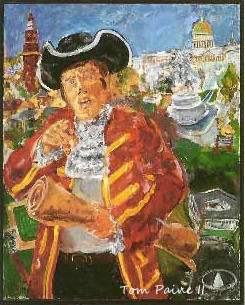Specifically, I claim is that an
official government publication loses its legitimate protection against a suit
for declaratory relief, when the publication includes misrepresentations
intended to suppress public debate on the issues that the plaintiff
advocates. To me this would seem a
keystone principle of republican government.
Conceivably, it's a matter of first impression. If so, it's ripe for decision.
A free-speech precedent [14] for jurisdiction
is Bernstein v. United States Dept.
of Justice, 192 F.3d 1308 (9th Cir. 1999), which granted declaratory relief, holding
that plaintiff's free speech rights were violated by a regulation where the responsible
"government official or agency [had]
substantial power to discriminate based on the content or viewpoint of speech
by suppressing disfavored speech." [15] Unlike my complaint, which also alleges the
incidental violation of two constitutional provisions, Bernstein alleged no
more than the deprivation of his First Amendment rights.
A misrepresentation precedent is Kearney v.
Foley & Lardner , 590 F.3d 638 (9th Cir. 2009),
which held that a government agency or official's conduct, even with the
additional immunities of a litigant, loses all legitimacy and so immunity, by
"intentional misrepresentations," or by "furnishing with predatory intent false
information," so as to foil the contrary petitions of a private party. Kearney also observed that the right to
petition generally protects incidental conduct, including "the use of 'the
channels and procedures' of state and federal courts to advocate causes."
Finally, I should add that the trial court is supposed to
decide First Amendment cases promptly. City
Of Littleton v. Z.J. Gifts D-4, L.L.C. , 541 U.S. 774, 786 (2004) (Stevens dissent: "mere
possibility of promptness is emphatically insufficient to guard against the
dangers of unjustified suppression of speech").
[1] The Federal
Reserve recognizes that the seigniorage it garnishes is a taking of tax. See, e.g., 2001
FOMC minutes , page 15.
[2] See the Fed
website page How much does it cost to produce currency and coin?
[3] "Money should belong
to the people, not the banks, and should be issued in sufficient quantity to
meet the productive capacity of the nation, not withheld from circulation by
banks that did nothing to deserve it." A
complete monetary reform package is incorporated in HR 2990
(the "Need" act), sponsored by Dennis Kucinich.
See also the American Monetary Institute .
[4] Print costs are
trivial, due to $100 bill demand. The
print counts for 2010 were: 1,856
million $1 bills; and 1,907 million $100
bills.
[5] See Currency in
Circulation. For 2011 print volumes,
values, costs, see 2011 New Currency Budget.
[6] 1990 GAO report, page 9.
[7] The
state of U.S. coins and currency , July 20, 2010 testimony
of Louise Roseman,
Director, Division of Reserve Bank (emphasis added).
[8] Before the recent bouts of quantitative
easing, physically printed notes represented about 95% of all notes
issued. It now represents only about 37%
of them. See William Hummel 's
December 4, 2011 response to my
question on his "understandingmoney.com" blog.
Next Page 1 | 2 | 3 | 4 | 5 | 6 | 7 | 8
(Note: You can view every article as one long page if you sign up as an Advocate Member, or higher).





